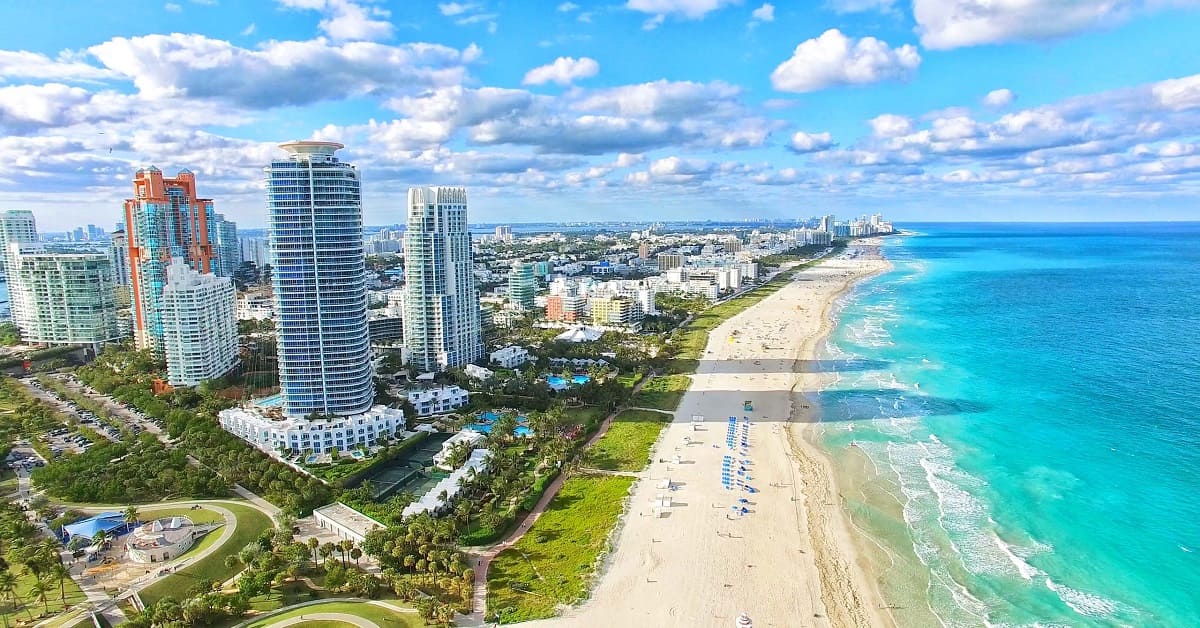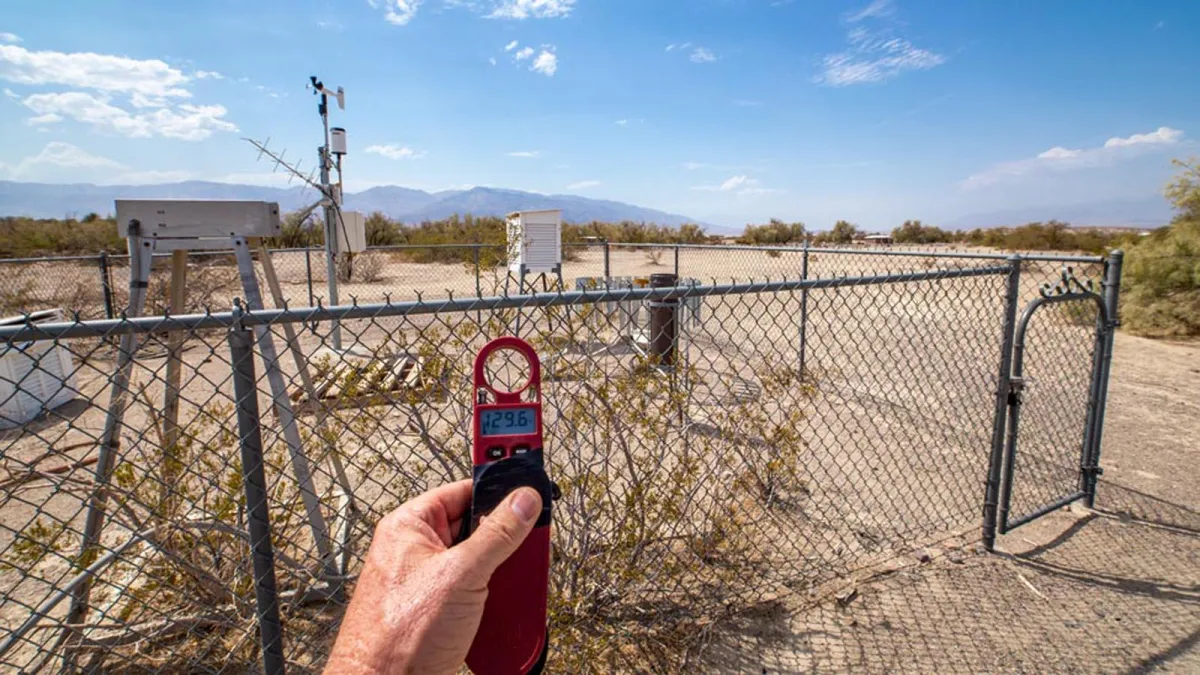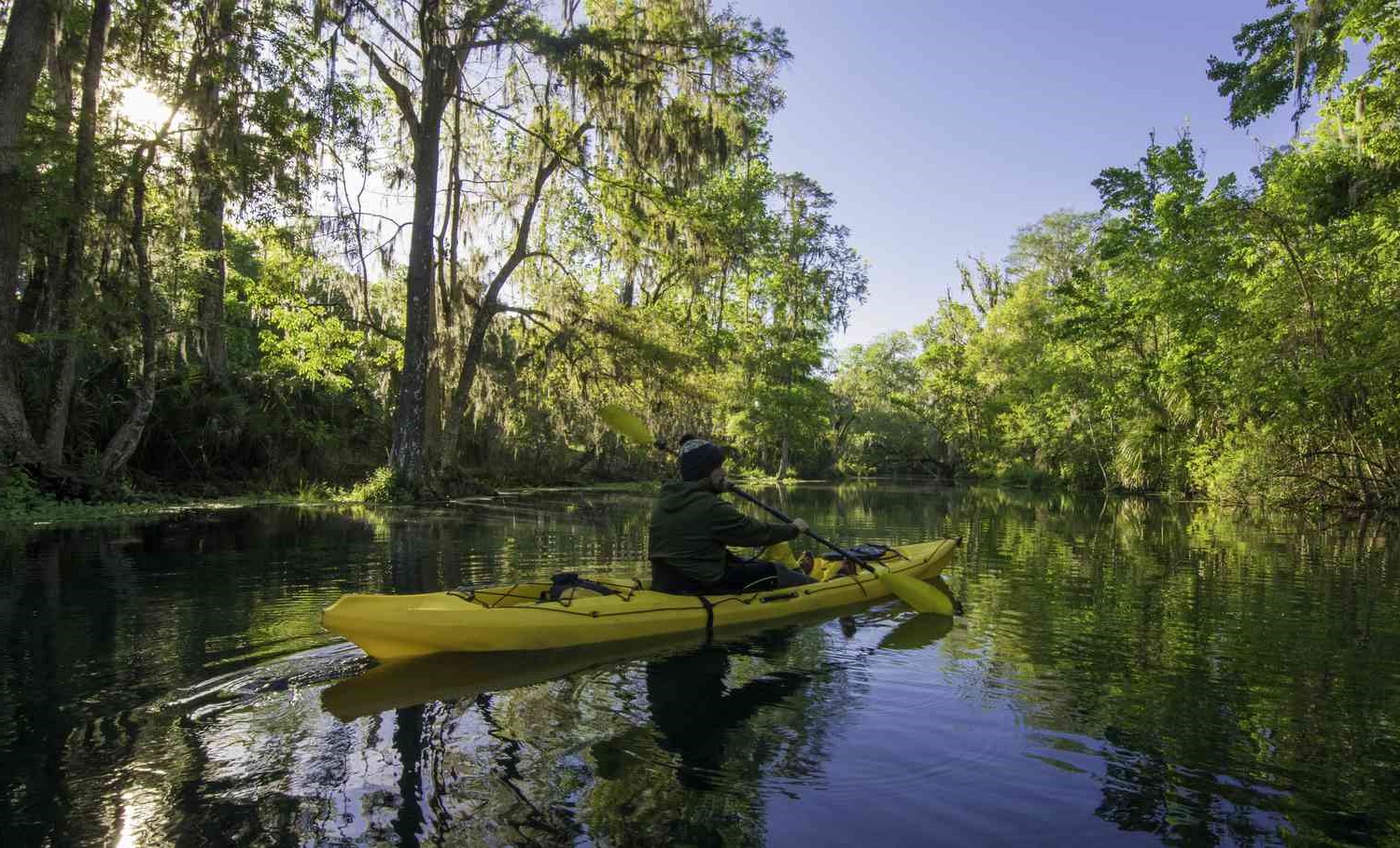Home>Weather and Climate>Florida’s Record-Breaking Highest Temperature


Weather and Climate
Florida’s Record-Breaking Highest Temperature
Modified: April 30, 2024
Discover the impact of Florida's highest temperature on its weather and climate. Learn about the record-breaking heat and its effects. Explore more about weather and climate in Florida.
(Many of the links in this article redirect to a specific reviewed product. Your purchase of these products through affiliate links helps to generate commission for Temperatures.com, at no extra cost. Learn more)
Table of Contents
Introduction
Florida, known for its stunning beaches, vibrant culture, and diverse ecosystems, is also no stranger to scorching temperatures. As the Sunshine State, Florida experiences a subtropical and tropical climate, characterized by hot and humid conditions for a significant portion of the year. The state's climate is influenced by its proximity to the Gulf of Mexico and the Atlantic Ocean, as well as its geographical location, which exposes it to the influence of various weather systems.
In recent years, Florida has witnessed record-breaking high temperatures, raising concerns about the potential impacts on both the environment and the residents. The increasing frequency of extreme heat events has prompted a closer examination of the factors contributing to these soaring temperatures and the measures being taken to mitigate their effects.
In this article, we will delve into the intricacies of Florida's climate, explore the factors that contribute to record-breaking temperatures, and examine the impacts of high temperatures on the state's diverse ecosystems. Additionally, we will analyze historical temperature data to gain insights into the trends and patterns of extreme heat events in Florida. Furthermore, we will shed light on the efforts being made to address the challenges posed by rising temperatures and mitigate their adverse effects on the environment and communities.
Join us on a journey through Florida's climate and the implications of its record-breaking highest temperatures as we unravel the complexities of this pressing issue and explore the strategies aimed at safeguarding the state's natural heritage and the well-being of its inhabitants.
Read more: Portland’s Highest Recorded Temperature
Understanding Florida's Climate
Florida's climate is characterized by its subtropical and tropical attributes, creating a unique environment that shapes the state's weather patterns and temperature variations. Situated in the southeastern region of the United States, Florida experiences a climate influenced by its proximity to the Gulf of Mexico and the Atlantic Ocean. The state's geographical location exposes it to the influence of various weather systems, contributing to the diversity of its climate.
The subtropical climate of Florida is defined by its long, hot summers and relatively mild winters. During the summer months, the state experiences high temperatures and high humidity levels, creating a sweltering and often oppressive environment. The combination of heat and humidity can result in heat index values that pose significant challenges to residents and visitors alike.
The tropical climate elements are particularly evident in South Florida, where the warm waters of the Gulf Stream contribute to the region's distinct weather patterns. The influence of the Gulf Stream can lead to rapid and intense thunderstorms, especially during the summer months, adding to the dynamic nature of Florida's climate.
The state's unique geography, including its extensive coastline and the presence of numerous lakes and wetlands, further contributes to the complexity of its climate. The interaction between land and water, as well as the presence of diverse ecosystems, plays a crucial role in shaping local weather conditions and temperature variations.
Florida's climate also exhibits a marked seasonality, with distinct wet and dry seasons. The wet season, typically spanning from May to October, brings frequent thunderstorms and heavy rainfall, contributing to the state's lush vegetation and diverse ecosystems. In contrast, the dry season, which extends from November to April, is characterized by lower humidity levels and reduced precipitation.
Understanding Florida's climate involves recognizing the interplay of various factors, including its geographical location, proximity to water bodies, and the influence of prevailing weather systems. The state's climate not only shapes its natural landscapes but also significantly impacts the daily lives of its residents and the myriad ecosystems that call Florida home.
Factors Contributing to Record-Breaking Temperatures
The record-breaking temperatures experienced in Florida can be attributed to a confluence of factors that interact to create extreme heat events. Understanding these contributing factors is essential in comprehending the complexities of the state's temperature variations and the challenges posed by soaring mercury levels.
Urbanization and Heat Island Effect
The rapid urbanization and extensive development in Florida's urban centers have led to the emergence of urban heat islands. These areas, characterized by dense infrastructure and limited green spaces, absorb and retain heat, resulting in elevated temperatures compared to surrounding rural areas. The heat island effect exacerbates the already high temperatures in urban environments, contributing to record-breaking heat events.
Climate Change and Greenhouse Gas Emissions
The overarching influence of climate change cannot be overlooked when examining the factors contributing to record-breaking temperatures in Florida. The rise in global temperatures due to increased greenhouse gas emissions has a direct impact on the state's climate. Florida's vulnerability to the effects of climate change, including rising sea levels and more frequent extreme weather events, amplifies the likelihood of soaring temperatures and heatwaves.
Weather Patterns and Air Masses
The interplay of weather patterns and air masses significantly influences Florida's temperature extremes. The state's proximity to the Gulf of Mexico and the Atlantic Ocean exposes it to varying air masses, including warm, moisture-laden air. These air masses, combined with prevailing weather patterns, can lead to prolonged periods of intense heat, contributing to record-breaking temperatures.
Vegetation and Land Use Changes
Changes in vegetation cover and land use can impact local temperature dynamics. Deforestation, urban expansion, and alterations to natural landscapes can disrupt the balance of heat absorption and dissipation, leading to localized temperature spikes. The loss of vegetative cover and the transformation of natural areas into urban or agricultural landscapes can contribute to the intensification of high temperatures in specific regions.
Solar Radiation and Heat Accumulation
Florida's abundant sunshine and prolonged exposure to solar radiation play a pivotal role in driving up temperatures, especially during the peak of summer. The state's geographical location and subtropical climate result in extended daylight hours and intense solar radiation, leading to heat accumulation and the potential for record-breaking high temperatures.
By examining these multifaceted factors, we gain valuable insights into the intricate mechanisms that contribute to record-breaking temperatures in Florida. The convergence of urbanization, climate change, weather patterns, land use changes, and solar radiation underscores the complexity of the state's temperature dynamics and the imperative of addressing these contributing factors to mitigate the impacts of extreme heat events.
Impacts of High Temperatures on Florida's Ecosystem
The soaring temperatures in Florida exert profound impacts on the state's diverse ecosystems, influencing the delicate balance of its natural environments and the myriad species that depend on them. From the expansive wetlands and marshes to the lush forests and coastal habitats, the effects of high temperatures reverberate throughout Florida's ecological tapestry.
Stress on Wildlife and Fauna
The elevated temperatures place significant stress on wildlife and fauna, disrupting their behavioral patterns, reproductive cycles, and foraging activities. Species adapted to specific temperature ranges may struggle to cope with prolonged heatwaves, leading to altered migration patterns and shifts in habitat utilization. Furthermore, the increased heat can result in dehydration and heat stress among wildlife, posing a threat to their survival.
Impact on Aquatic Ecosystems
Florida's aquatic ecosystems, including its intricate network of rivers, lakes, and coastal waters, are particularly vulnerable to the impacts of high temperatures. Elevated water temperatures can disrupt the balance of aquatic life, affecting fish populations, aquatic plants, and invertebrates. Additionally, heat-induced changes in water temperature can lead to reduced oxygen levels, impacting the overall health of aquatic ecosystems and contributing to instances of fish kills and algal blooms.
Stress on Plant Communities
The state's diverse plant communities, ranging from mangroves and cypress swamps to pine forests and coastal dunes, face heightened stress due to extreme temperatures. Prolonged heatwaves can lead to moisture deficits in the soil, affecting the growth and vitality of vegetation. Furthermore, increased temperatures can exacerbate the risk of wildfires, posing a threat to Florida's forested landscapes and the species that depend on these habitats.
Impact on Coral Reefs
Florida's iconic coral reefs, including the expansive Florida Reef Tract, are susceptible to the impacts of high temperatures. Elevated sea surface temperatures can trigger coral bleaching, a phenomenon where corals expel the symbiotic algae living in their tissues, leading to widespread coral mortality. The bleaching events not only jeopardize the health of coral reefs but also disrupt the intricate marine ecosystems they support, affecting fish populations and other marine organisms.
Disruption of Ecosystem Services
The cumulative impacts of high temperatures on Florida's ecosystems can disrupt the vital services they provide, including water purification, flood control, and habitat provision. The loss of biodiversity and ecological resilience due to extreme heat events can compromise the capacity of ecosystems to sustainably support human well-being and maintain the delicate balance of nature.
The far-reaching impacts of high temperatures on Florida's ecosystems underscore the urgency of addressing the challenges posed by extreme heat events. By understanding and mitigating these impacts, efforts can be directed towards safeguarding the state's natural heritage and promoting the resilience of its diverse ecosystems in the face of rising temperatures.
Historical Data of Florida's Highest Temperatures
Florida's historical temperature records provide valuable insights into the state's climatic trends and the occurrence of extreme heat events. The analysis of historical temperature data offers a comprehensive understanding of the magnitude and frequency of record-breaking high temperatures, shedding light on the evolving climate dynamics in the Sunshine State.
Over the decades, Florida has witnessed notable instances of exceptionally high temperatures, with specific regions experiencing remarkable heat spikes. The historical data reveals a pattern of increasing temperature extremes, indicating a discernible trend towards higher and more frequent occurrences of record-breaking heat in the state.
One of the most noteworthy historical temperature milestones in Florida is the recording of the highest temperature ever observed in the state. This significant event occurred in 1931, when the mercury soared to a staggering 109 degrees Fahrenheit (42.8 degrees Celsius) in Monticello, marking a pivotal moment in Florida's climatic history. The record-setting temperature not only underscored the intensity of heat that the state can experience but also served as a benchmark for evaluating subsequent temperature extremes.
In addition to individual temperature records, the historical data encompasses the analysis of prolonged heatwaves and extended periods of elevated temperatures across various regions of Florida. These prolonged heat events, characterized by sustained high temperatures and limited relief, have left indelible imprints on the state's climate history, shaping the narrative of extreme heat in Florida.
Furthermore, the historical temperature data highlights the spatial variability of record-breaking temperatures, illustrating the localized nature of extreme heat events within Florida. From the urban centers to the rural landscapes, the historical records delineate the diverse geographical contexts in which high temperatures have made their mark, offering a nuanced perspective on the distribution and intensity of extreme heat across the state.
The comprehensive analysis of historical temperature data serves as a crucial foundation for understanding the evolving climate patterns and the implications of rising temperatures in Florida. By examining the historical records of Florida's highest temperatures, researchers and climate scientists can discern the underlying trends and patterns, informing proactive measures to address the challenges posed by extreme heat and mitigate its impacts on the state's ecosystems and communities.
The historical data of Florida's highest temperatures not only provides a retrospective view of past climatic events but also serves as a vital tool for anticipating and preparing for future temperature extremes. As Florida continues to grapple with the ramifications of rising temperatures, the historical temperature records offer valuable lessons and insights, guiding efforts to foster resilience and adaptability in the face of a changing climate.
Efforts to Mitigate the Effects of Extreme Heat in Florida
Efforts to mitigate the effects of extreme heat in Florida encompass a multifaceted approach aimed at addressing the challenges posed by soaring temperatures and safeguarding the well-being of both the environment and the populace. These proactive measures, driven by a commitment to resilience and sustainability, seek to mitigate the impacts of extreme heat events and foster adaptive strategies to enhance the state's capacity to cope with rising temperatures.
Urban Planning and Green Infrastructure
Urban planning initiatives in Florida emphasize the integration of green infrastructure, including the incorporation of parks, green spaces, and urban forests, to mitigate the urban heat island effect. By strategically integrating vegetation and natural elements into urban landscapes, these efforts aim to reduce heat retention, enhance air quality, and create cooler microclimates within urban environments. Furthermore, the implementation of reflective and permeable surfaces in urban design contributes to minimizing heat absorption and mitigating the adverse effects of high temperatures in densely populated areas.
Heat Emergency Preparedness and Public Health Initiatives
In response to the escalating risks associated with extreme heat, Florida has implemented comprehensive heat emergency preparedness plans and public health initiatives. These initiatives focus on raising awareness about heat-related illnesses, providing access to cooling centers during heatwaves, and offering targeted support to vulnerable populations, including the elderly and individuals with pre-existing health conditions. By prioritizing public health and proactive measures, these initiatives aim to reduce the incidence of heat-related illnesses and mitigate the impacts of extreme heat on communities across the state.
Climate-Resilient Infrastructure and Sustainable Development
The integration of climate-resilient infrastructure and sustainable development practices plays a pivotal role in mitigating the effects of extreme heat in Florida. Infrastructure projects that prioritize heat-resilient design, such as cool pavements and green roofs, contribute to minimizing heat absorption and enhancing the adaptive capacity of urban areas. Additionally, sustainable development practices, including energy-efficient building designs and the promotion of renewable energy sources, align with efforts to reduce heat emissions and mitigate the exacerbation of high temperatures due to urban heat islands.
Ecosystem Conservation and Restoration
Conservation and restoration initiatives targeting Florida's diverse ecosystems are instrumental in mitigating the effects of extreme heat on the state's natural landscapes. These efforts focus on preserving critical habitats, implementing water conservation measures, and restoring degraded ecosystems to enhance their resilience in the face of rising temperatures. By safeguarding the ecological integrity of Florida's wetlands, forests, and coastal areas, these initiatives contribute to mitigating the impacts of high temperatures on wildlife, flora, and the provision of essential ecosystem services.
Research and Community Engagement
Research endeavors and community engagement initiatives play a pivotal role in advancing the understanding of extreme heat impacts and fostering community resilience. Collaborative research projects focused on heat mitigation strategies, climate adaptation, and the development of early warning systems for heatwaves contribute to evidence-based decision-making and the formulation of targeted interventions. Furthermore, community engagement programs empower residents to adopt heat-smart practices, promote sustainable behaviors, and participate in local initiatives aimed at mitigating the effects of extreme heat.
By embracing a comprehensive and collaborative approach, Florida is actively pursuing initiatives to mitigate the effects of extreme heat, foster climate resilience, and protect the well-being of its ecosystems and communities. These concerted efforts underscore the state's commitment to addressing the challenges posed by rising temperatures and creating a sustainable and adaptive future for all Floridians.
Read more: How To Record And Track Temperature Readings
Conclusion
In conclusion, Florida's record-breaking highest temperatures underscore the intricate interplay of climatic factors, human activities, and ecological impacts, shaping the narrative of extreme heat in the Sunshine State. The understanding of Florida's climate, characterized by its subtropical and tropical attributes, provides a foundational framework for comprehending the complexities of temperature variations and the challenges posed by soaring mercury levels.
The factors contributing to record-breaking temperatures, including urbanization, climate change, weather patterns, land use changes, and solar radiation, highlight the multifaceted nature of extreme heat events in Florida. These contributing factors not only underscore the complexity of the state's temperature dynamics but also emphasize the imperative of addressing them to mitigate the impacts of high temperatures on the environment and communities.
The impacts of high temperatures on Florida's ecosystems, encompassing stress on wildlife and fauna, disruption of aquatic ecosystems, challenges to plant communities, and the vulnerability of coral reefs, underscore the far-reaching consequences of extreme heat events. These impacts emphasize the urgency of proactive measures to safeguard the state's natural heritage and promote the resilience of its diverse ecosystems in the face of rising temperatures.
The historical data of Florida's highest temperatures provides valuable insights into the evolving climate patterns and the implications of rising temperatures in the state. By examining the historical records, researchers and climate scientists can discern the underlying trends and patterns, informing proactive measures to address the challenges posed by extreme heat and mitigate its impacts on the state's ecosystems and communities.
Efforts to mitigate the effects of extreme heat in Florida, encompassing urban planning, public health initiatives, sustainable development practices, ecosystem conservation, and community engagement, underscore the state's commitment to resilience and sustainability. These proactive measures aim to foster adaptive strategies to enhance Florida's capacity to cope with rising temperatures and mitigate the impacts of extreme heat events on both the environment and the populace.
In essence, Florida's record-breaking highest temperatures serve as a call to action, prompting collaborative efforts to address the challenges posed by extreme heat and create a sustainable and adaptive future for the state. By embracing a comprehensive and collaborative approach, Florida is actively pursuing initiatives to mitigate the effects of extreme heat, foster climate resilience, and protect the well-being of its ecosystems and communities.










